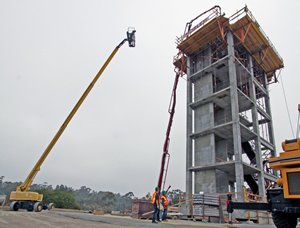Sept 23, 2011
Two graduate students look on as construction crews pour the roof slab on a five-story building at Englekirk Center. The building will be outfitted to test nonstructural components, including a working elevator, stairs, a sprinkler system and medical equipment.
Structural engineers at the UC San Diego Jacobs School of Engineering are preparing for a series of earthquake tests focused on nonstructural components, including a functioning elevator, stairs, ceilings, and passive and active fire suppression systems, such as sprinklers and partition walls, in a full-scale, five-story concrete building on the world’s largest outdoor shake table.
The tests performed at the Englekirk Structural Engineering Center at UC San Diego will be the first of their kind in the United States to focus on a broad range of systems and equipment that can malfunction during an earthquake and make it more difficult to evacuate buildings, which can lead to more injuries and deaths.
Construction crews recently completed the five-story structure with a final pouring of the roof slab. The structure is uniquely outfitted with nonstructural systems that are found in multi-use office and hospital buildings. The top two floors will feature patient beds, a patient lift, computers and other hospital equipment that are common to California medical facilities, including a complete intensive care unit and surgery suite.
“We know very little about the earthquake and post-earthquake fire performance of nonstructural systems in buildings, and even less about those in hospitals,” said Tara Hutchinson, a professor of structural engineering at the Jacobs School and principal investigator for the component of the testing program supported by the National Science Foundation. “Meanwhile, lives and property are being lost due to nonstructural damage, even under moderate seismic events.”
“While building codes in California have attempted to address this by strengthening the requirements for nonstructural components in recent years, components designed to these new requirements have not yet been tested in strong earthquakes,” Hutchinson said. “These tests will help fill this gap in knowledge,” she added.
At 25 ft. by 40 ft., the UC San Diego-Network for Earthquake Engineering Simulation Outdoor Shake Table is the largest shake table in the United States and the largest outdoor shake table in the world. The powerful hydraulic actuators at UC San Diego’s facility can simulate ground motion speeds up to six ft. per second, allowing researchers to create realistic simulations of the most devastating earthquakes on record.
Once construction crews install all non-structural components, engineers will subject the entire five-story building to large simulated earthquakes and fire tests from January through March 2012. Media will be invited to observe key tests during this time and should contact the press office at the Jacobs School of Engineering for updates as the test schedule is developed.
Source: University of California, San Diego

1 comments:
Hi there. Nice blog. You have shared useful information. Keep up the good work! This blog is really interesting and gives good details. elevator manufacturer, Passenger lift.
Post a Comment